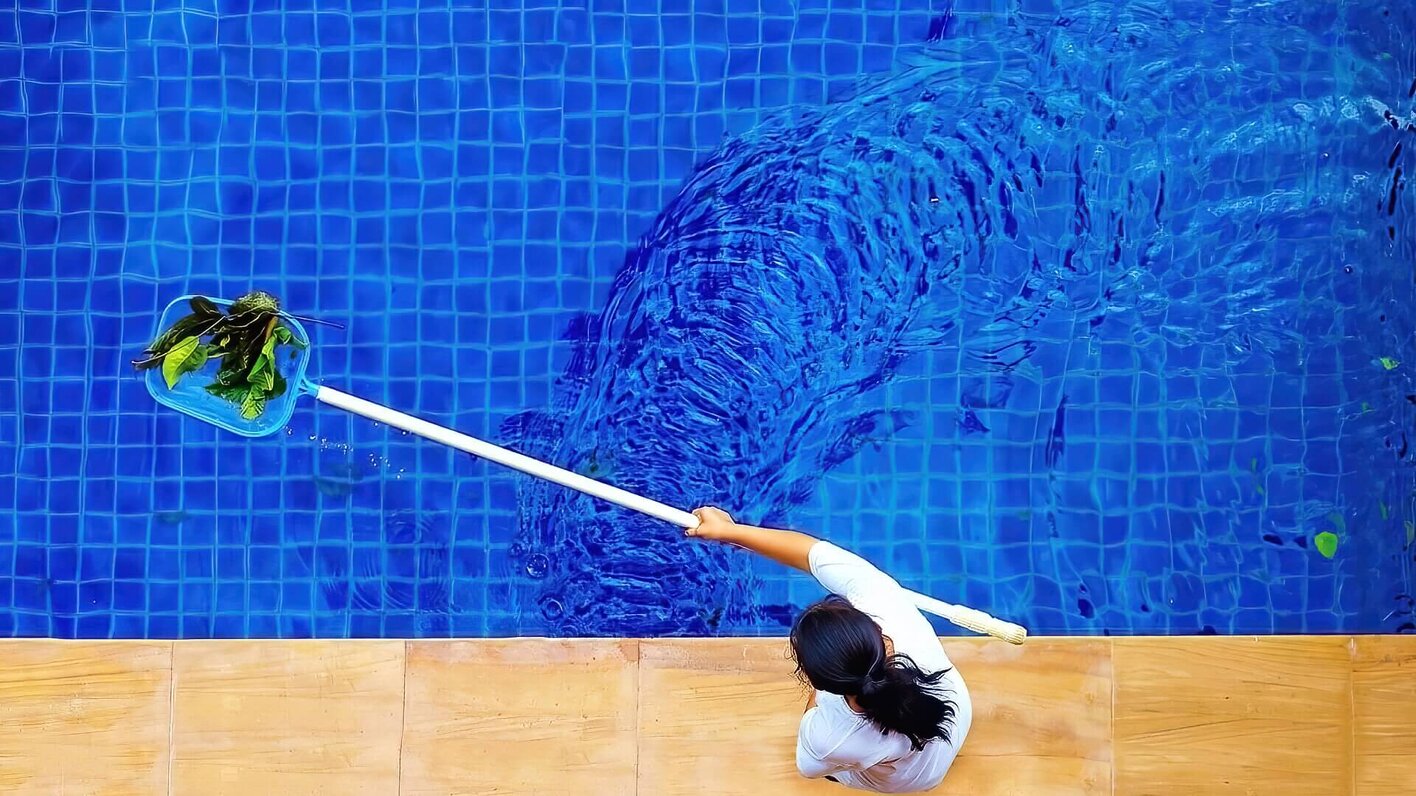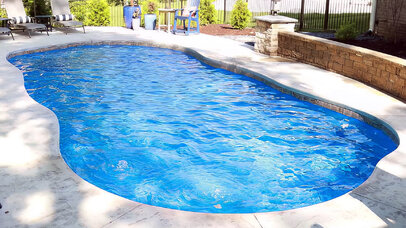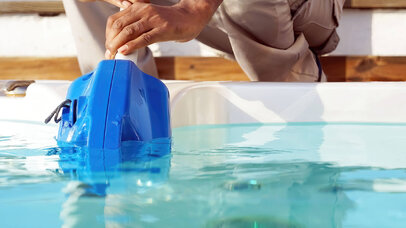Owning a pool is fun, but it comes with many responsibilities.
And although it’ll take some time to get familiar with pool care, it’ll become part of your routine once you get the hang of it. If you’ve recently invested in a brand-new pool, ensuring its long-term functionality and beauty is paramount. That’s where professional pool maintenance services come in.

Incidentally, those who recently installed a new pool might struggle with the maintenance. So, to help you care for your pool in the best possible way, we’ve compiled an easy guide that acts as a go-to manual.
This will help you DIY the pool care tasks without hiring a professional. Our short but complete resource is the perfect place to start for basic working knowledge about pool management. So, read until the end to know all about swimming pool maintenance!

Pool Components You Should Know About
First, you must understand the different parts of maintaining a healthy swimming pool and a proper pool maintenance schedule. Most basic pool components remain pretty much the same whether you have a concrete, fibreglass, or vinyl in-ground pool. To avoid confusion, you must know some parts before diving into the maintenance aspect.
1. Pool Filter
Every pool will have a filter by default. Pool filters play a vital role in maintaining water cleanliness. The three main types include sand filters, cartridge filters, and DE filters, all serving the same purpose of effective cleaning. It’s not a big deal if you aren’t sure about the kind of filter you have. But cleaning your pool filter regularly and knowing the type will surely help if there is a need to replace it someday.
2. Pump
An electric motor pushes the water towards the filter and back to the pool regularly; this device is commonly called a pool pump.
3. Drainage System
Check the bottom of your pool, and you’ll find 2 or 3 drains that add and remove pool water. These use a low-power suction to remove the debris that otherwise sinks to the bottom.
4. Skimmers
A skimmer is a small drain you see around the pool edges. Its purpose is to drain out unwanted dirt, leaves, or bugs before they drop to the bottom.
Swimming Pool Maintenance Essentials
We’ve divided the maintenance essentials into three parts:
- Cleaning The Pool
- Pool Circulation System
- Water Chemistry
Cleaning The Pool
Here are the supplies you require to keep a clean and healthy pool:
Supplies Required
- Vacuum system
- Pool brush
- Skimmer net
- Filter cleaner
- Cleaning agents
- Pool Shock
Essential Cleaning Guide For Spotless Swimming Pools

We get it; you don’t want to spend all your free time cleaning the pool. But if you schedule regular cleaning days, the process won’t get as overwhelming as cleaning once in a few months. Engaging in regular pool maintenance, including manual cleaning and proper chemical treatment like chlorine, is essential to prevent the growth of harmful microbes.
Conduct regular research and monitoring to maintain optimal pool chemistry, including the pH levels of your pool’s water. For expert advice on maintaining a healthy pool, consider consulting with professionals at your local pool shop who have extensive knowledge and experience in pool maintenance.
Now, let’s take a look at how to maintain your pool!
1. Skim The Water
Attach a skimmer net to a long pole, available at any store in the pool accessories section. This forms a basic net you need to skim over the water’s surface. Leaves, dried twigs, or insects cannot be cleaned from the regular filtration system, so this method takes care of larger debris.
2. Clean The Pool Filter
As we mentioned before, there are usually three filter systems for pools. Your cleaning technique will depend on the filter installed in your pool. If you have a cartridge filter, remove the cartridge film and wash it until it’s clean. Over time, the film may need replacement, but it is not required for every cleaning session.
3. Scrub The Pool Walls
You will need some simple pool equipment for this step! The pool wall collects dust, grime, and pool algae, so a quick brush along the walls will keep them clean. Attach the brush tool to the cleaning pole and work around the swimming pool. Make sure you cover all corners, including the ladder.
4. Vacuum The Pool Floor
The swimming pool floor tends to get neglected because some DIY-ers don’t know how to reach the bottom without draining the water. Vacuuming is easy and doesn’t require the elaborate process of draining and refilling the pool water.
Attach your vacuum hose to the pole and dip the head in the water. Fill the vacuum with water while keeping the other end of the hose open to allow air to escape. Next, ask a friend to turn off the filter while the vacuum head remains submerged. Attach the hose to the skimmer and adaptor, then switch the pool filter setting to “waste removal.”
Once you start the system again, the grime and water will directly exit through the attached drain. Glide the hose across the floor and switch it off when complete. Lastly, remove the hose from the vacuum and switch the motor setting to “filter”.
You can also purchase a robotic pool cleaning system with a higher budget. This way, you can set times for your pool to be cleaned and sit back and relax. Self-cleaning saltwater pools are available for those seeking low-maintenance options, although they may require a higher initial investment.
5. Clean Your Pool Deck
If you have the luxury of a pool deck, don’t forget to clean your pool deck after you’ve finished cleaning the entire pool. The deck gets slippery from dirt and algae, so be cautious when cleaning this portion. Use a regular cleaning agent and a long brush to scrub through all the sides.
Pool Circulation System
Stagnant water is the perfect home for bacterial and microbial growth. Just as water outdoors remains fresh and clean because it’s always moving, pool water needs constant movement, too. The pool pump and motor filter ensure that the water in the pool is constantly in motion, thus preventing the growth of algae and microbes.
Ideally, a swimming pool pump and filter system should always run, even throughout the night. But that isn’t practically possible for everyone. So, you could run the filter for 12 to 13 hours per day to keep the water circulating. Turn on the backwashing periodically to release the dirt from the pool.
Keep the filter clean and in good condition for a longer lifespan. If the filter works well, there will be less clogging and pressure breakage.
Water Chemistry
Test The Pool Water Chemistry

You may be wondering why it’s necessary to spend time learning chemistry when you only want to relax in a pool! The correct chemical balance in your pool gives it a sparkling clean appearance. If the pool chemicals balance is off, algae overgrowth is likely. And we’re sure you’d agree that swimming in a murky, algae-infested pool doesn’t sound fun.
Swimming in a pool that has turned green due to algae growth is far from enjoyable and aesthetically pleasing.
It’s unnecessary to test the pH frequently, but it’s a good idea to do so if the pool has seen more visitors than usual. External factors like rain can also change the chemistry, and it might need additional cleaning after weeks of use.
Using A Strip Kit
A pool water testing kit is a quick and inexpensive way to determine the pH of the pool water. You only need to dip the thin paper strip in your swimming pool and hold it still for a minute. Then, take it out of the water and give it time to dry.
After a while, the test strips will naturally take on one colour. After testing the pool water with the strip kit, consult the instruction guide for appropriate measures. Keeping the chlorine levels stable is crucial, with an ideal pH level of around 7.5 indicating a slightly alkaline condition.
Maintaining Your Pool
It is always recommended to keep your pool clean. Whether the pool is old or new, maintaining it will allow you and your family to enjoy a clean place to beat the heat. Regular maintenance is also worth it since the result is satisfying.
In fact, like many other pool owners, you might find yourself taking pride in and enjoying the rituals to keep the pool in good condition. So, we hope you found our helpful guide and get a chance to apply the maintenance methods to your pool. An alternative heating option is electric heating systems, which can be valuable to your pool maintenance setup. In colder months, pool covers prevent debris from entering the pool and aid in retaining heat, especially when combined with solar heating systems.
Until next time, have a nice swim, and good luck with getting the right water balance!



